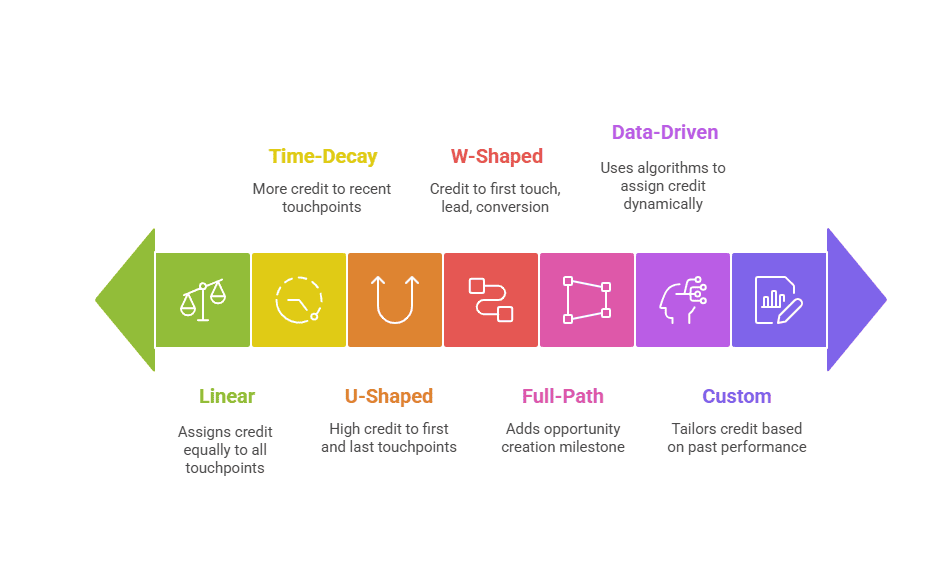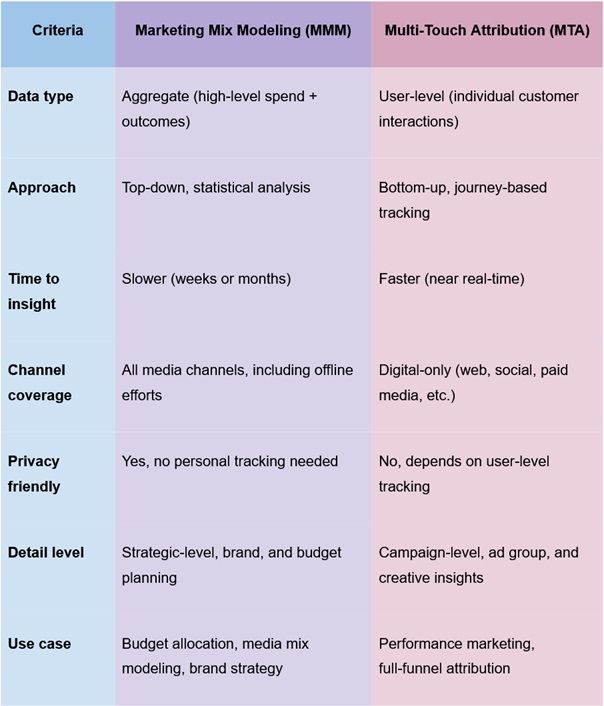Important tool updates - Learn more
- Learn
-
Articles
Read about influencer marketing
-
Growthnotes - Newsletter
Insights for the modern marketer
Attribution models have never mattered more than they do now. With ad costs rising, privacy regulations tightening, and offline channels making a comeback, knowing what’s driving performance is everything.
Two major contenders lead the race: Marketing Mix Modeling (MMM) and Multi-Touch Attribution (MTA). Both promise clarity, but deliver it in very different ways.
So, which model actually works best? Remember that the right answer depends on your business needs, your data, and your goals.
This blog breaks it down clearly. You’ll learn:
P.S. Struggling to find a team that actually knows how to run MMM or set up MTA properly? A full-service marketing agency can help you model your media mix, set up attribution tools, and connect the dots between spend and outcomes, without wasting time or budget.
MMM (Marketing Mix Modeling) uses aggregate historical data and statistical analysis to measure the impact of all marketing channels, including offline, on business outcomes.
MTA (Multi-Touch Attribution) uses user-level data to track customer journeys across digital channels and assigns credit to multiple touchpoints.
MMM strengths: holistic cross-channel view, privacy-friendly, works in cookieless environments, incorporates external factors, effective for budget allocation and long-term planning.
MTA strengths: near real-time insights, granular campaign-level data, supports personalization, faster setup for digital campaigns, effective for short-term optimization.
MMM limitations: slower to deliver insights, requires large volumes of clean historical data, resource-intensive setup, less granular.
MTA limitations: privacy compliance challenges, limited to digital channels, complex implementation, depends on complete tracking data.
Best use: MMM for strategic planning, brand growth, and offline media impact; MTA for optimizing digital performance and touchpoint-level decisions.
Optimal approach: Combining both provides long-term clarity and short-term control, covering strategic budget allocation and daily campaign optimization.
Marketing mix modeling is a method that helps brands understand how different marketing efforts, like TV ads, Google Ads, or social media, impact sales or leads. It uses historical data and statistical analysis to show what’s working across all channels, including offline ones. Instead of individual customers, MMM focuses on overall trends.
Marketing mix modeling takes a top-down, statistical approach to measure the impact of your marketing spend. It doesn’t track individual users; instead, it looks at aggregate data like weekly ad spend, sales numbers, and media exposure over time.
You feed the model historical data across all marketing channels, TV, radio, digital marketing, print, and even offline efforts. Then, through regression analysis, MMM identifies which activities actually drive results like sales performance or customer acquisition.
What makes MMM powerful is its ability to account for external factors like holidays, economic trends, weather, or even competitor activity. These variables can heavily influence outcomes, and MMM brings them into the picture.
It’s most useful for long-term strategic planning, budget optimization, and understanding how to distribute spend across your full marketing mix.
If you want a high‑level view of what’s really moving the needle across all your marketing channels, MMM delivers.
According to a July 2024 eMarketer survey, 53.5 % of US marketers already use MMM, and 30.1 % say it’s the best approach for identifying what actually drives business outcomes. Of course, effectiveness depends on data quality and execution.
Now, let’s see why many digital marketers and strategy teams rely on it:

MMM has its strengths, but it’s not the fastest or easiest model to work with. For many teams, the setup can feel like a heavy lift, especially without the right data or people in place.
Below are some of the common challenges:
Multi-touch attribution tracks a customer’s full journey across digital channels and assigns credit to multiple touchpoints along the way. It uses user-level data to show how different interactions, like a Facebook ad, email, or Google search, combine to drive conversions. MTA helps you optimize digital campaigns by revealing what actually influenced the outcome.
For example, a user might see a display ad, click a Google search result a few days later, and then convert after opening an email. Instead of giving all the credit to the last click, MTA shows how each step contributed to the final action, so you know which touchpoints truly mattered.
MTA takes a bottom-up approach, using user-level data to track customer interactions across digital channels. Every click, view, or visit is tied to a real person.
It maps the full conversion path and assigns value to each touchpoint along the way. That means you can see how display ads, search clicks, social media interactions, and email newsletters work together to drive action.
Since the data updates in near real-time (typically updating within hours or days), MTA helps digital marketers quickly optimize creative, bidding, and targeting. It’s most useful for performance-driven campaigns where every customer touch point matters.
There are several ways to assign credit within MTA:

If you’re running digital campaigns and want clarity on what’s actually driving results, MTA has some serious advantages. According to the MMA Global report, over 50 % of marketers were already using MTA in 2024, with 57 % calling it an essential part of their measurement toolkit.

Let’s explore what makes it valuable:

MTA offers deep insight, but it’s not perfect, and definitely not plug-and-play. Here’s where it can fall short:
MMM and MTA solve different problems, even though both fall under the umbrella of attribution modeling. MMM takes a top-down approach, using aggregate data to show how your overall marketing mix impacts business outcomes like sales or leads. It’s great for high-level decisions, budget allocation, and understanding long-term trends.
MTA takes the bottom-up route, using user-level tracking to follow each step of the customer journey across digital marketing channels. It’s built for campaign-level insights, fast feedback loops, and optimizing digital performance.
Now, let’s explore a side-by-side breakdown:

There’s no single “best” model. The better model depends on what you’re measuring, the kind of data you have, and how quickly you need answers. Use the guide below to match your situation with the right approach:
If your focus is on big-picture planning, brand growth, or overall media effectiveness, MMM is the smarter fit. For marketers focused on performance metrics, targeting, and customer interactions across digital channels, MTA delivers more relevant insights.
MMM depends on large, accurate datasets, things like weekly marketing spend, sales performance, and media exposure, collected over months or years. If you have that kind of historical coverage, MMM can deliver solid results.
MTA, on the other hand, needs detailed user-level tracking across digital touchpoints. That includes clickstream data from your website, ad interactions from platforms like Google Ads or Facebook, and behavioral info from your CRM or email tools.
If you need quick feedback to tweak live campaigns, MTA gives you almost real-time visibility (as we explained above, with some hours of delay). If you're focused on long-term strategy and broader performance trends, MMM delivers better clarity over time.
If you’ve got access to data scientists and know your way around regression analysis, MMM is a solid option. If your team’s stronger on digital tracking, analytics tools, and connecting user-level data across platforms, MTA is likely a better fit.
Use MMM when you need channel-level guidance or overall media mix optimization. But if you're after detailed insights on specific ad groups, creatives, or audience segments, MTA is the better fit.
MMM will benefit you more if you are running TV, radio, or other offline marketing channels. However, if your campaigns live on paid search, social media, or programmatic, MTA gives you what you need.
Both models require a budget, but in different ways. MMM can be heavy on setup and modeling, whereas MTA often needs strong martech infrastructure and clean tagging across assets.
If you’re serious about marketing performance measurement, you don’t have to choose one model over the other. In fact, many top brands use both.
MMM gives you the strategic view of how your overall marketing budget is working across all channels, including offline media like TV, radio, and print. MTA fills in the tactical gaps, showing how individual touchpoints in your digital campaigns contribute to conversions.
When used together, they cover both ends of the spectrum. You get long-term clarity and short-term control, strategic planning and daily optimization, big-picture budget allocation, and granular creative-level insights.
Some brands even connect the two models with shared inputs, feeding user-level MTA outputs into MMM frameworks to improve accuracy and alignment.
So, if you’ve got the resources, combining both gives you the best shot at making smarter decisions across every part of your marketing mix.
As noted by Recast:
“Brands looking for 100% clarity in marketing measurement by using just one method won’t find it... you can get as close as possible by combining and triangulating between them.”
Attribution isn’t one-size-fits-all. MMM and MTA serve different goals, and depending on your data, timeline, and team, one may suit you better than the other. The smartest brands don’t treat them as either/or. They treat them as complementary tools that help answer different questions.
Key takeaways
If you’re looking to improve attribution without overcomplicating your stack, expert agencies like inBeat can help. Their team helps you build clear, efficient, and performance-driven marketing systems, MMM, MTA, or both.
Which one is the most effective attribution model?
There’s no universal “best” model. MMM works well for strategic planning and measuring full-channel impact, while MTA is better for campaign-level optimization. The most effective approach depends on your goals, data, and media mix. Many brands combine both to get long-term clarity and short-term control.
What's the difference between single-source attribution and multi-touch attribution models?
Single-source models, like first or last touch, assign 100% credit to one interaction. Multi-touch attribution (MTA) spreads credit across multiple touchpoints based on how each contributed to the conversion path. MTA provides a more complete view of customer behavior but requires deeper tracking and setup.
What model does MMM use?
Marketing mix modeling (MMM) uses statistical models, often regression analysis, to connect historical marketing spend and external factors to business outcomes like sales. It doesn’t rely on user-level data. Instead, it looks at trends over time across all media channels to estimate which tactics had the most impact.
What is the preferred method of multi-touch attribution to get the most valid results?
Data-driven MTA is the most reliable method. It uses machine learning to assign credit based on actual performance patterns rather than fixed rules. Unlike linear or time decay models, it adapts to real customer behavior and delivers more accurate insights if you have the right data and setup.
What is the drawback to using the last touch attribution model?
Last touch attribution ignores the full journey. It gives 100% credit to the final interaction, even if multiple ads or touchpoints influenced the decision. That can lead to poor optimization choices and undervaluing top and mid-funnel efforts like brand awareness or content marketing.
Can you use MMM and MTA together?
Yes, and many leading brands do. MMM provides a strategic view across all channels, including offline, while MTA gives tactical insights for digital campaigns. Used together, they offer full-funnel clarity, big-picture planning, and detailed optimization. Some teams even link outputs from MTA into MMM for deeper accuracy.